If you read Schneider Shorts on Fridays, you will sure have heard of Dror Kolodkin-Gal, the research integrity businessman from Israel, and his image analysis company Proofig. Which is nowadays extremely popular among scholarly publishers, simply because Dror uses his Proofig to tell journal editors what they want to hear: that there are no fake figures in their journals. Just slanderous allegations by envious losers on PubPeer.
How does Proofig work, if it even works? A closely-guarded secret – Dror never reveals details and never lets expert image integrity sleuths to have a peek. He also refuses to test his software on the publications of his wife, the former Weizmann Institute professor Ilana Kolodkin-Gal. For a good reason.
Part 1. Ilana
I briefly wrote about Ilana’s bad science in 2017, focussing on her 2010 paper in Science which was corrected in 2011 but still had problems. Back then, the young Israeli microbiologist ran her own successful lab at the prestigious Weizmann Institute, despite a retraction of a Cell paper from 2015 from her postdoc period in Harvard, USA, with Richard Losick.
The PubPeer Stars of Weizmann Institute
Rony Seger, Jacob Hanna, Ilana Kolodkin-Gal, Atan Gross, Sima Lev, Tsvee Lapidot, Moshe Oren, Varda Rotter and others. Let’s celebrate the Weizmann Science!
Soon after, around 2018, Ilana was made a professor, she was celebrated as a rising star of Israeli biomedicine and a role model for women in science. Yet another Weizmann press release wrote about her in 2020:
“Prof. Ilana Kolodkin-Gal’s research is supported by the Kekst Family Institute for Medical Genetics; the Angel Faivovich Foundation for Ecological Research; the estate of Helen Nichunsky; the estate of Raymond Lapon; and the estate of Albert Engleman. Prof. Kolodkin-Gal is the incumbent of the Rowland and Sylvia Schaefer Career Development Chair in Perpetuity. “
The retraction was not deemed as a problem, rather a proof of her great integrity as a scientist. In fact, the retraction notice from May 2015 stated:
“In this article, we reported that norspermidine is produced in aged biofilm cultures of Bacillus subtilis and that norspermidine could disassemble and inhibit B. subtilis biofilms. Both claims have been challenged by Hobley et al. (2014, Cell 156, 844–854). We have subsequently repeated the experiments and have found that the new results can no longer support our original conclusions. Therefore, the most appropriate course of action is to retract the article. We offer our apologies for these errors and for any inconvenience that they may have caused.”
Ilana Kolodkin-Gal, Shugeng Cao , Liraz Chai , Thomas Böttcher , Roberto Kolter, Jon Clardy, Richard Losick A Self-Produced Trigger for Biofilm Disassembly that Targets Exopolysaccharide Cell (2012) doi: 10.1016/j.cell.2012.02.055
In reality, the data was just fudged just like in other papers by Kolodkin-Gal. This was flagged already in 2015:

More recently, Elisabeth Bik found more:

Green boxes: The Compound 15/250 uM well looks remarkably similar to the Compound 17/500 uM well.“
In May 2021, an Expression of Concern followed in PLOS Biology, for Ilana’s PhD paper with Hanna Engelberg-Kulka at the Hebrew University of Jerusalem:
Ilana Kolodkin-Gal, Boaz Sat , Alex Keshet , Hanna Engelberg- Engelberg-Kulka The communication factor EDF and the toxin-antitoxin module mazEF determine the mode of action of antibiotics PLoS Biology (2008) doi: 10.1371/journal.pbio.0060319
The Expression of Concern detailed various instances of image manipulation, but ending with:
“The PLOS Biology Editors concluded that the main conclusions of the article appear to be supported by the data provided in post-publication discussions. However, we issue this Expression of Concern due to the extent of image issues identified in [1] and the nature of the issues raised for Figures S3 and S4 that remain unresolved. The authors acknowledge the potential errors during the assembly of Figures S3 and S4.
The available original and replicate data to support the article’s results, including those discussed above, can be requested from the corresponding author.”
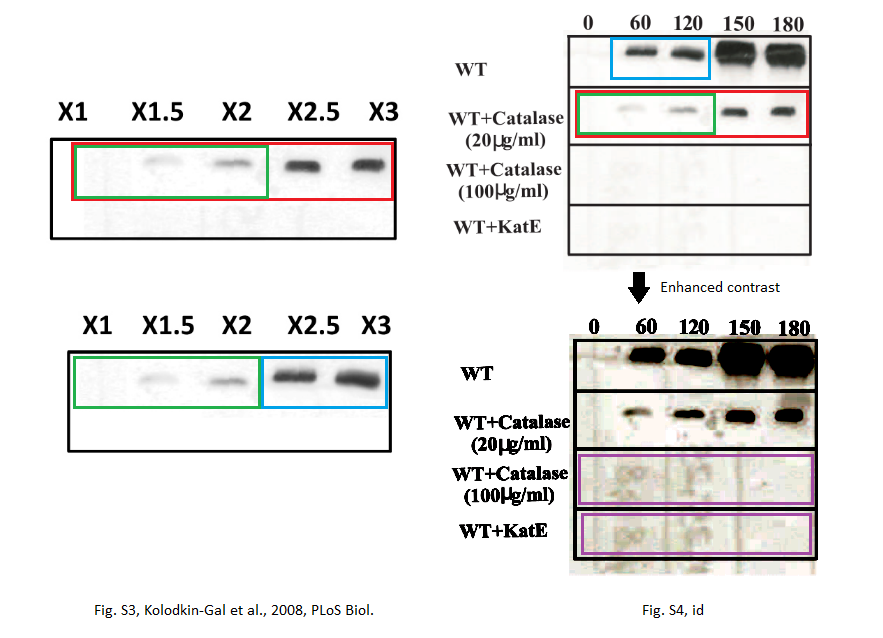
Absolutely nobody is interested in addressing this never-corrected beauty, recently updated Bik:
Anna L. McLoon , Ilana Kolodkin-Gal , Shmuel M. Rubinstein , Roberto Kolter , Richard Losick Spatial Regulation of Histidine Kinases Governing Biofilm Formation in Bacillus subtilis Journal of Bacteriology (2011) doi: 10.1128/jb.01186-10


As mentioned, there are more problematic papers by Ilana on PubPeer, all from Ilana’s PhD and postdoc period. Dror recently declared those image duplication problems to have happened due to his wife’s “dyslexia” (i.e, reading difficulties), he also stated to be screening her lab’s papers to avoid further “mistakes” for her:
“As I wrote, my wife, she is an excellent and honest scientist and thanks to Proofig she can now avoid mistakes caused by dyslexia. We act transparently and work with integrity experts. It looks like nobody update you any more :).“
Actually when I wrote to Ilana to inquire about her alleged dyslexia, she replied with an empty mail. Proof, I guess?
That “reply” came from Ilana’s alternative email address, at the Hebrew University. When I wrote to her official email address at Weizmann, I received this:
“I am no longer affiliated with the Weizmann Institute of Science. Please contact me with this e. mail at the Hebrew University of Jerusalem“
At the same moment, the Kolodkin-Gal lab on Weizmann website looked perfectly active, with 7 members (of them 3 PhD, archived here) students are a recruitment ads for technicians.

On her private website, Ilana Kolodkin-Gal states she left Weizmann in 2021, which makes one wonder why Weizmann still keeps up the pretence in 2023. Also no mention of her former Professor title, just “senior Scientist”. Same personal website mentions:
“Current Affiliation: https://plantpathology.agri.huji.ac.il/“

But she is not listed among “academic staff” or anywhere else at the linked Department of Plant Pathology and Microbiology of the Faculty of Agriculture. As she mentions elsewhere, Ilana only holds an adjunct affiliation at the Hebrew University of Jerusalem, probably once obtained thanks to her mentor Engelberg-Kulka. Adjunct affiliations are generally unpaid and involve no lab or office facilities. Does Ilana have a lab still? Or any job in science? Her department colleagues didn’t answer to my email inquiry.
Ilana for sure has a lot of time on her hands now, and she battles her dylexia by writing papers. Here is one in Frontiers, Kolodkin-Gal 2023:
The Frontiers paper is really something, read for yourself:
“Many brilliant scientists had dyslexia, including Michael Faraday, Galileo Galilei, and Thomas Alva Edison. […] My particular diagnosis (in addition to having multiple ADHD symptoms) for learning disabilities from 2001 includes (but is not limited to) difficulty in memorizing number sequences, difficulty in data retrieval in short problems, and remembering details from complex texts; difficulty in isolating specific details during visual scanning; lack of planning in relation to the page layout during figure copying and drawing tasks; attention deficits, poor memory of information of complex figures and individual symbols. Retrospectively, many of my issues also fall into the relatively non-characterized learning disorder, NVLD. Any of the above, and a combination thereof, makes one most vulnerable to sub-perform in STEM. Indeed, my earlier works included some mistakes now appropriately corrected/acknowledged by Scientific journals. I also recognize that the overall understanding of editors and collaborators with whom I shared the full diagnosis was untrivial. Only as an independent investigator did I become aware of artificial intelligence software to do quality control before publication.”
But Ilana also publishes actual research papers, here is most recent Maan et al 2022, with her as corresponding author with Hebrew University affiliation:
In the tweet, Ilana acknowledges her “dear friend and collaborator” Jonathan Friedman, who is listed as assistant professor where she is not listed at all. Of the three people who are reported to have done the experiments and affiliated at Weizmann, two work at core facilities and the first author is Ilana’s former PhD student, Harsh Maan, already left. Basically, it may look like Ilana’s research continues at Hebrew University, but she is actually wrapping up what was left back at Weizmann. Her scientific career is likely over, and not because of dyslexia.
Gosh, what skills did Ilana’s “talented PhD Harsh Maan” learned under her tutelage? Let’s have another at her PubPeer record.
This paper was not yet flagged on PubPeer when it was pre-emptively fixed with a correction in February 2021:
Sathish Kumar , Ilana Kolodkin-Gal , Oliver Vesper , Nawsad Alam , Ora Schueler-Furman , Isabella Moll , Hanna Engelberg-Kulka Escherichia coli Quorum-Sensing EDF, A Peptide Generated by Novel Multiple Distinct Mechanisms and Regulated by trans-Translation mBio (2016) doi: 10.1128/mbio.02034-15
The Correction stated:
“The positive-control complemented strain pzwf and negative-control mutant sample pzwf701AAA chromatogram were used multiple times in the figures in this manuscript only for clarity of the readers, since all the other sample peaks were compared with these two control samples. All experiments were performed with three consistent independent repeats.”
Two months later, in April 2021, someone (probably same whistleblower) posted the evidence on PubPeer:





Now, it is clear the editors who issued that correction had same evidence available and knew how badly manipulated the graphs really were. But you see, the mBio‘s founding and current Editor-in-Chief is the Johns Hopkins University professor Arturo Casadevall, who used to prance around as world’s greatest champion of research integrity, i.e., up until his own papers were exposed as fraudulent, and which he refused not only to retract, but even to correct.
The Redemption of Arturo Casadevall
Arturo Casadevall is probably the most recognized expert for research integrity, author of many peer reviewed papers on that topic. But now his own publications on microbiology and immunity are under scrutiny.
No wonder Casadevall let this slide:
Sathish Kumar , Ilana Kolodkin-Gal , Hanna Engelberg-Kulka Novel Quorum-Sensing Peptides Mediating Interspecies Bacterial Cell Death mBio (2013) doi: 10.1128/mbio.00314-13

This gel, flagged in November 2021, just doesn’t look real. But someone must have convinced the editors of the opposite. Now, it is quite likely that the editorial decision to disregard all that evidence was based on a Proofig analysis, simply because Casadevall relied on Proofig already in 2021. When Casadevall was still one of the chief editors of the Journal of Clinical Investigation, he entered a business agreement with Ilana’s husband Dror:
In 2022, the JCI-Proofig partnership was celebrated by the new editorial team in an article titled: Data We Can Trust. More on that in the next part.

Part 2: Dror
With so much expertise in image integrity in the family, and fake science being a huge concern in scholarly publishing community these days, it was only logical that Ilan’s husband Dror opened a business. And this is how Proofig Ltd came to be, offering
“Automated Image Proofing for Scientific Integrity“
Of course Ilana, the hands-on image integrity expert, is on board, as she states on her website:
“I am extremely proud to be a part Proofiger LTD, the company that was founded by my husband Dr. Dror Kolodkin-Gal to correct the Scientific future.”
This is how the company advertises, with a quote of its owner:
Dr Dror Kolodkin-Gal: “As a senior researcher in life sciences, I became all too familiar with the damaging problem of inadvertent image duplication in scientific publications. My awareness of the massive prices paid by my colleagues and the esteemed journals in which their studies are published, which damages the integrity of the scientific process itself, is precisely what motivated me to found Proofig.”
Indeed, Ilana’s ceasing to be a Weizmann professor and pretending to run an invisible lab at Hebrew University can be counted among “the massive prices paid”.
But how does Proofig work? Does it work at all? Dror of course claims it is the best thing on the market:
Not everyone is convinced. Especially since Dror categorically refuses to test his amazing AI software on his wife’s papers.

Dror then announced to block Cheshire on Twitter because the latter kept suggesting that Dror screens Ilana’s papers with Proofig.
Let’s try to see how Proofig’s performs by reading the customer testimonies. Let#s start with the society-owned Journal of Clinical Investigation (JCI), mentioned above. Nature recently brought an article about the new policy at JCI, where whistleblowers now must declare their conflicts of interests so the editors find a ground to reject their evidence. It was about this editorial which I covered before.
Elizabeth M. McNally Conflicting interests: when whistleblowers profit from allegations of scientific misconduct Journal of Clinical Investigation (2022) doi: 10.1172/JCI166176
McNally’s decision to crack down on conflicted whistleblowers was motivated by the fact that some of them traded short-stocks of Cassava Sciences, a fraudulent biotech startup which ran fraudulent clinical trials and published fraudulent papers to push a fraudulent Alzheimer’s cure. That Photoshop fraud was for some reason was defended by several allegedly respectable journals, e.g. the society-owned Journal of Neuroscience. Read here:
Cassava fraud and Alzheimer’s capitalism
“even Theranos didn’t submit fake data to FDA”
Facts and Fiction of Cassava Sciences
Attack is the best form of defence. Especially when your commercial clinical research is tainted by preclinical Photoshop fraud.
The reason I am digressing here is a tiny side-note somewhere in its text of the Nature article:
” McNally says she hopes that her JCI editorial will remind other journals to be aware of conflicts of interest. (JCI’s investigation of the allegedly doctored image in its paper did not substantiate the whistle-blowers’ claim, she says.)”
It was about this paper, co-authored by Cassava’s scientist Hoau-Yan Wang, who is now under investigation by his City College of New York. The evidence of image data manipulation was collected by Matthew Schrag and Elisabeth Bik:
Konrad Talbot , Hoau-Yan Wang , Hala Kazi , Li-Ying Han , Kalindi P. Bakshi , Andres Stucky , Robert L. Fuino , Krista R. Kawaguchi , Andrew J. Samoyedny , Robert S. Wilson , Zoe Arvanitakis , Julie A. Schneider , Bryan A. Wolf , David A. Bennett , John Q. Trojanowski , Steven E. Arnold Demonstrated brain insulin resistance in Alzheimer’s disease patients is associated with IGF-1 resistance, IRS-1 dysregulation, and cognitive decline Journal of Clinical Investigation (2012) doi: 10.1172/jci59903


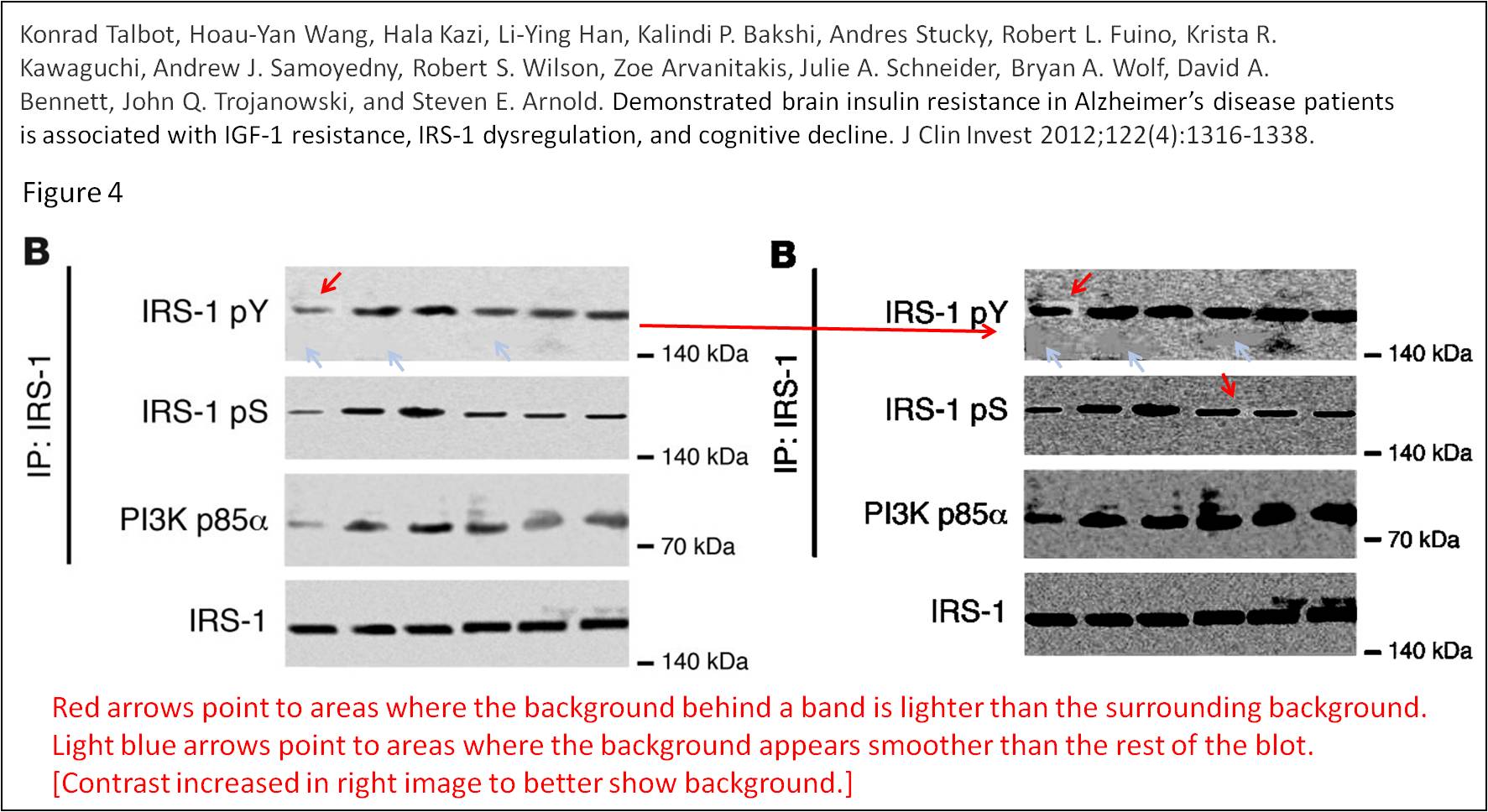
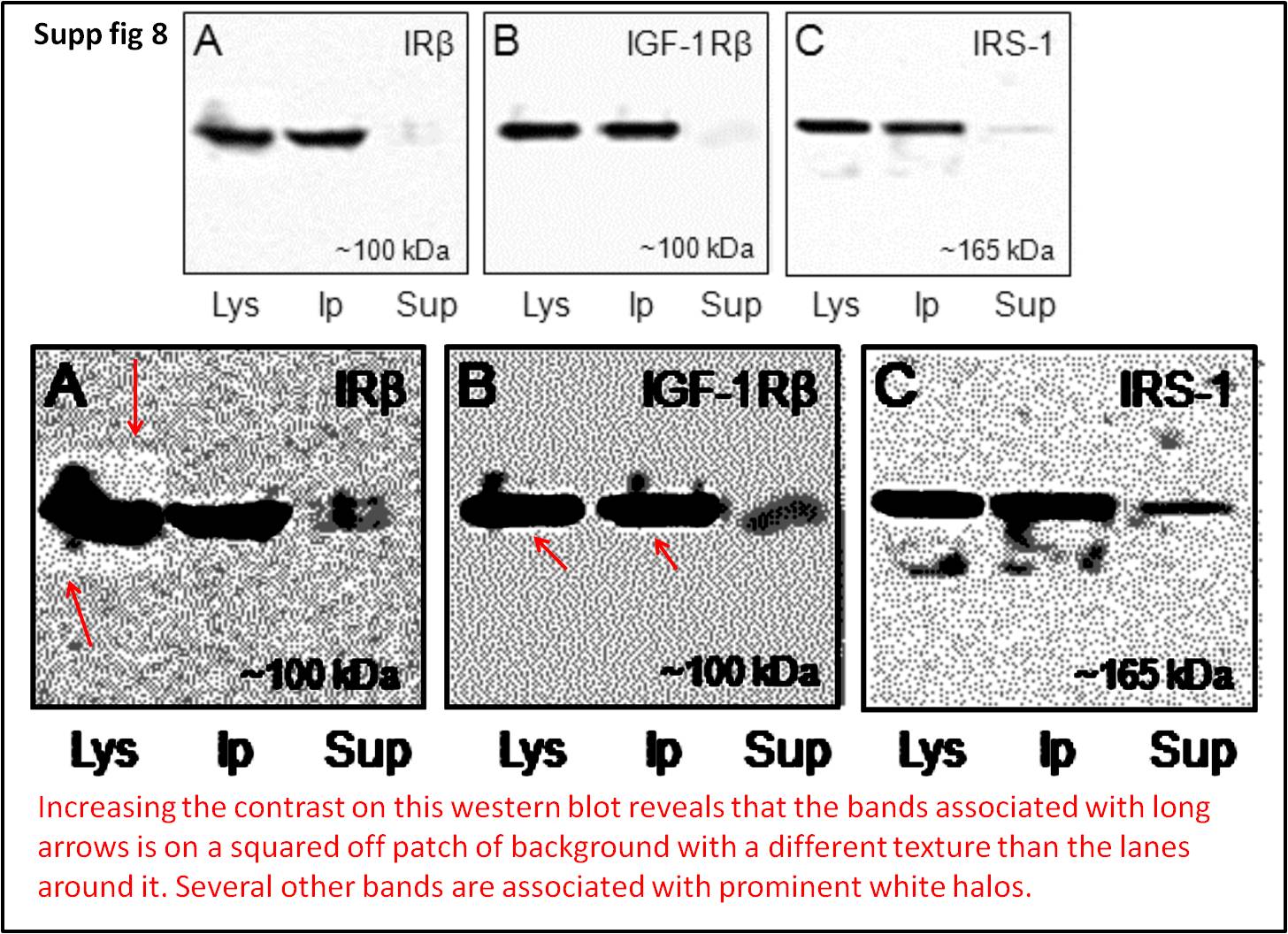
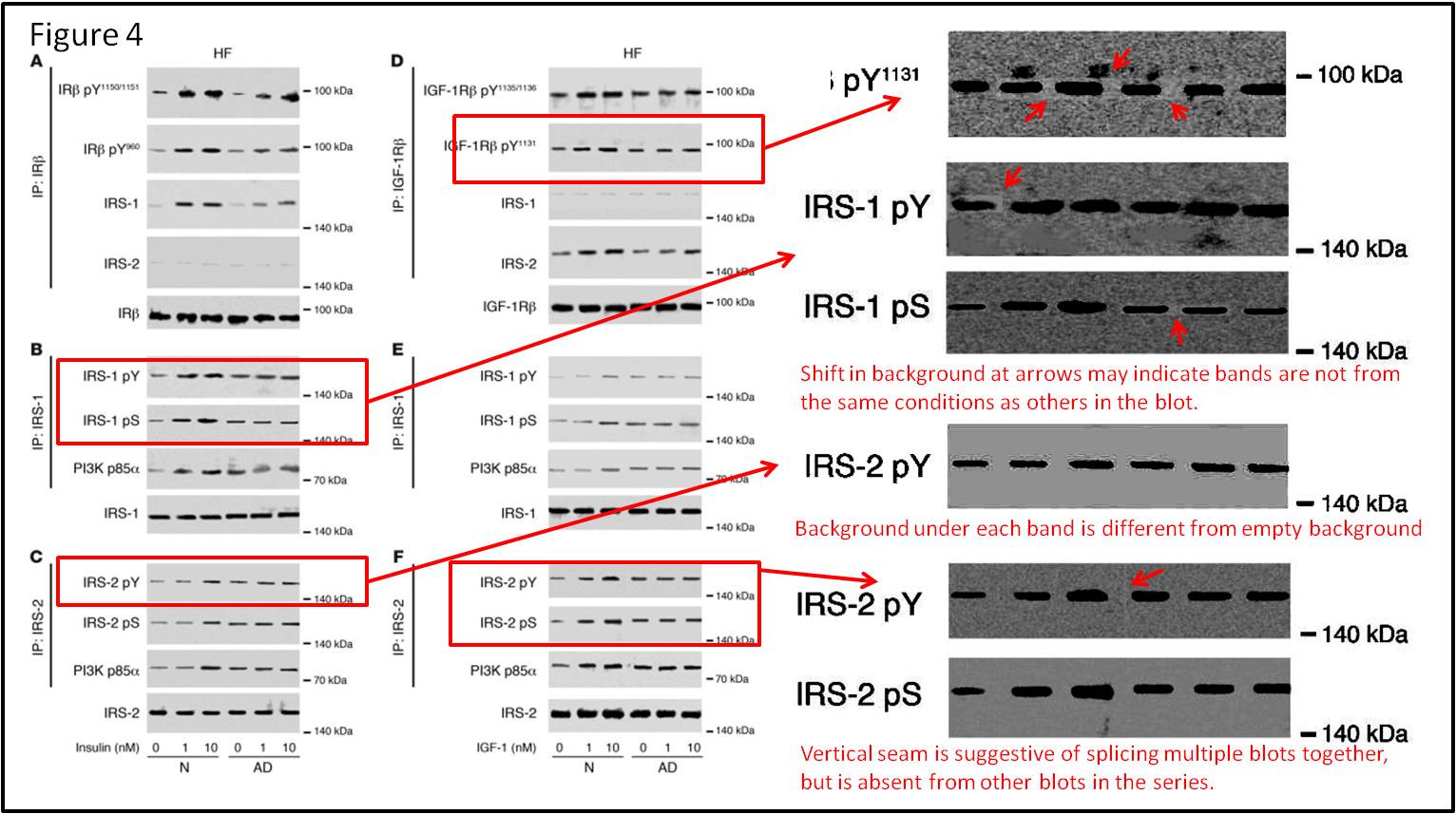

The first author Konrad Talbot from Loma Linda University (whatever that is) kept post lengthy explanation why there is absolutely nothing wrong with those rectangular boxes, but unconvincingly. Then it turned out, the error bars of the graphs were drawn by hand:

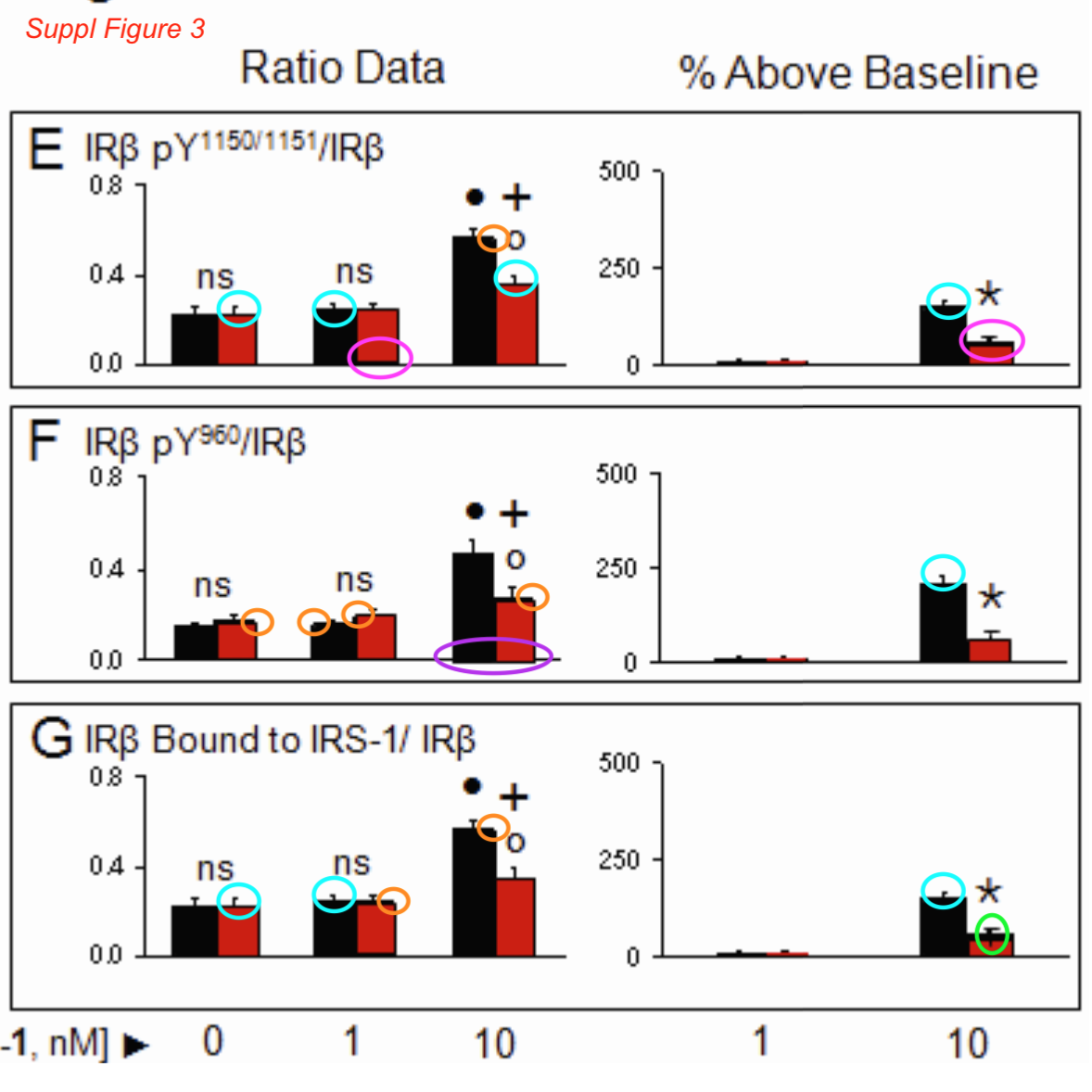

Now recall that journal’s new chief editor Elizabeth McNally‘s editorial “Data we can trust” from August 2022, where she stated:
“In July 2021, the JCI and JCI Insight implemented additional checks using Proofig (https://www.proofig.com/), a software that evaluates images for duplicated content.”
With his Proofig analysis, Dror not only reassured the JCI editors that Bik’s and Schrag’s PubPeer evidence is nothing but slanderous lies by greedy axe-grinding failed scientists, but he also greatly helped the fraudsters of Cassava. As he did for this Elsevier journal:
Hoau-Yan Wang , Kuo-Chieh Lee , Zhe Pei , Amber Khan , Kalindi Bakshi, Lindsay H. Burns PTI-125 binds and reverses an altered conformation of filamin A to reduce Alzheimer’s disease pathogenesis Neurobiology of Aging (2017) doi: 10.1016/j.neurobiolaging.2017.03.016




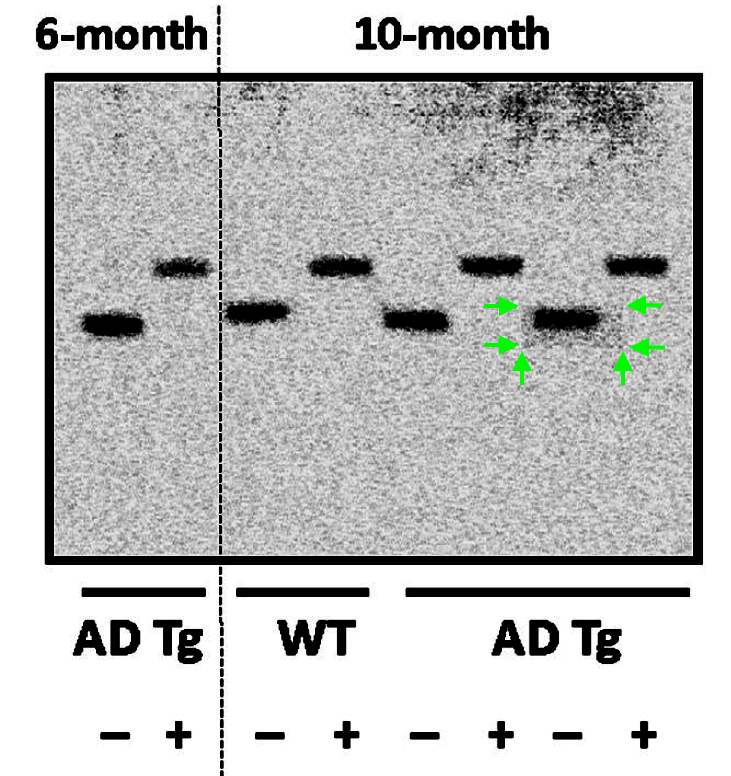


An Expression of Concern was issued in March 2022:
“The material was evaluated by an independent expert with relevant methodological expertise, the manuscript was scanned by AI-based figure proofing software (i.e., Proofig), and all available input was considered by the handling editor and Editor-in-Chief. Overall, the editors did not find compelling evidence of data manipulation intended to misrepresent the results.”
Dror keeps offering to educate his critics by email, but he never replies to mine. Shall we have more examples of Proofig’s performance?
How about a paper with a known US fraudster Thomas Webster, who was sacked in shame by his Northeastern University? I wrote about Webster before, when he announced to cure COVID-19 with nanoparticles, while Cheshire and other sleuths exposed his massive record of fake science and gift authorships:
Thomas Webster to save the world with COVID-19 nanoparticles
The world is in the grip of COVID-19 pandemic. Thousands dead, infection rates explode, nations in lockdown. Perfect timing for troll scientists to offer their bullshit cures. Like Thomas Webster of Northeastern University.
OK, ready to see the Webster paper?
Yanan Li , Yong Zhang , Pengmei Li , Gujie Mi , Jiasheng Tu , Linlin Sun , Thomas J. Webster , Yan Shen Ion-paired pirenzepine-loaded micelles as an ophthalmic delivery system for the treatment of myopia Nanomedicine Nanotechnology Biology and Medicine (2017) doi: 10.1016/j.nano.2017.05.001
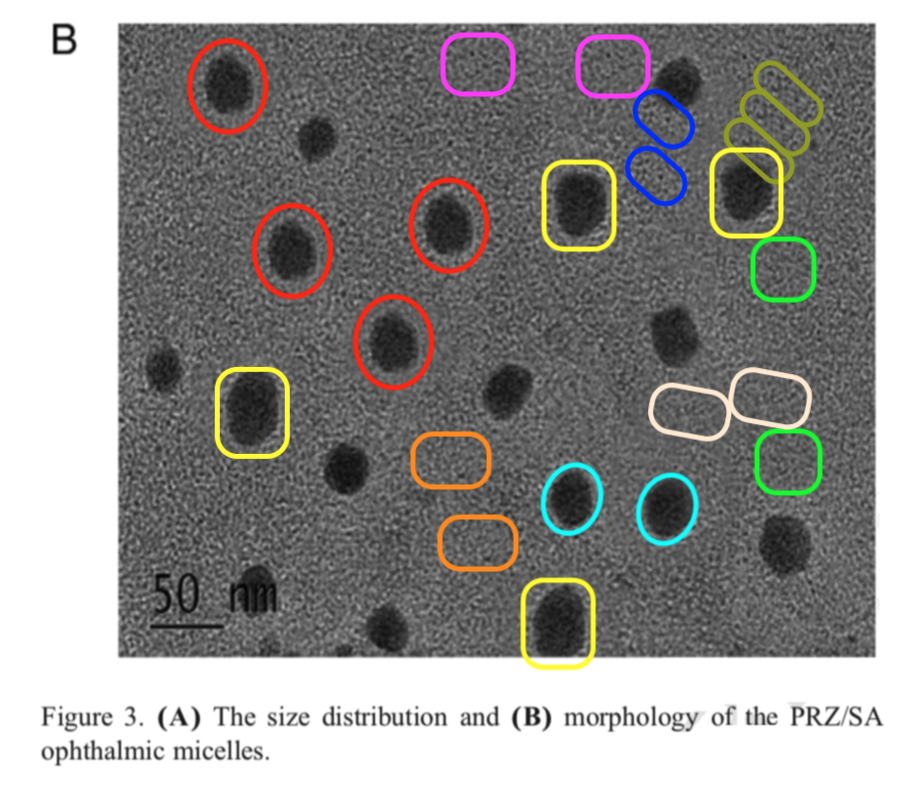
A ridiculously fake figure. But fixed with a Corrigendum in October 2020:
“In the original manuscript, there was an inadvertent mistake for Figure 3, B which appeared as a replicated image. We re-performed the entire set of the TEM experiments to rectify this mistake.”
Elisabeth Bik was of course not convinced and shared this on PubPeer (highlights mine):
“Concerns raised with the Committee on Publication Ethics (COPE) about the decision to issue a Correction – and replace Figure 3B with a completely different version – have been dismissed.
COPE decided:
“Upon consideration of the concerns and the member’s response, the Facilitation & Integrity subcommittee considers that the journal followed an adequate process to handle the concerns raised about the publication in Nanomedicine: Nanotechnology, Biology and Medicine and to correct the record when the need for this was confirmed. The journal reviewed the concerns about the image considering both the authors’ request and the reader’s concerns, and reached a decision after consultation between the editor and the publisher. The editor considered that the article conclusions remained unaffected and decided to post a Correction to address the errors in the figure.“
In the COPE report, the journal stated that the article’s figures were investigated using Proofig software, and that no findings were flagged by the software. It also stated that the change of image did not change the conclusions of the article.”
One really must entertain the possibility that Proofig does not work at all.
Another example.
How about a paper by none other but the French chloroquine quack and patient-abusing sociopath, Didier Raoult? Sounds trustworthy, right? Flagged by Bik in October 2021:
Zhongxing Liang , Bernard La Scola, Hubert Lepidi , Didier Raoult Production of Bartonella Genus-Specific Monoclonal Antibodies Clinical and diagnostic laboratory immunology (2001) doi: 10.1128/cdli.8.4.847-849.2001

The journal (now called mSphere) is published by the American Society for Microbiology (ASM) which once blacklisted Raoult for fraud, read here:
Chloroquine genius Didier Raoult to save the world from COVID-19
As COVID19 pandemic rages on, French microbiologist Didier Raoult offers a cure. President Trump is convinced, but is Raoult’s research reliable, here and in general?
Another PubPeer user found even more instances of data forgery and inappropriate data recycling in this publication. But then, in November 2022, someone arrived to declare:
“Ran Figure 1B sub images through Proofig and no suspected regions mentioned by #1 were found.“

It is not at all clear who posted the comment. Proofig is generally not available to others (e.g., Bik previously tried to test it, request denied). But it is not entirely unlikely that Raoult himself (or one of his IHU Marseille buddies) bought Dror’s “expert” services to negate all the PubPeer evidence of data forgery found by Bik and others in Raoult’s papers (note: much of Raoult’s PubPeer record concerns absence of ethics approvals or hidden COI). And then Raoult submitted Proofig analysis to the editors, which closed the case.
You think this is a wild and unlikely supposition? Really?
Here is the email which Dror sends out to advertise for his Proofig:
“Dear colleague,
As a senior researcher, you invest a lot of time in your scientific work.
Don’t let online controversies and aggressive blogs easily ruin
everything you’ve worked for to build your reputation. 20 to 35 per cent of life sciences articles contain errors within images (1,2), most of them because of honest mistakes. Whether the image issue is innocent or intentional, the outcome is still the same. Bloggers will attack that publication with image issues, which will damage your reputation and may even lead to a costly investigation.We are here to help you prevent this. I am Dr. Dror Kolodkin Gal, a senior researcher in virology and cancer research and the founder of Proofig.
Proofig is an automatic system based on AI and advanced algorithms.
Proofig results are fully confidential and provide you with the best pre-publication automatic detector of image duplication and manipulation so you can publish with peace of mind again. Proofig was created by researchers — for researchers.”
Those are the references:

Obviously Dror, whose product is already used by several scholarly society publishers, is reaching out to research fraudsters and papermillers to offer his services: Let me remove those give-away fraud traces before you get caught. With aggressive blogs he means For Better Science of course, which was the only one reporting about his wife’s problematic research.
Now, it is clear that Dror pursues two sources of income.
- Selling Proofig services to journal editors and scholarly publishers to reassure them that the whistleblower evidnece of image manipulation is all wrong
- Selling Proofig services to bad scientists to help them avoid getting caught by the journal editors and scholarly publishers.
Now wouldn’t it be logical to sell your services to both parties at the same time? First screen the manuscript for authors, take money, then screen that same manuscript for the editors, take money again?
Or even better: reach out to cheating scientists caught with fake figures who struggle to avoid a retraction. Take their money, submit your report to the journal, ideally take money there as well. Watch the case close, everyone happy, a win-win-win situation for all three parties.
A perfect circular system. Dror did not reply to any of my emails when asked to deny if he might be selling his services to the exactly same people whom he is paid to be investigating on behalf of the journals.
Dror and Ilana set up the perfect business. Everyone loves Dror and his Proofig. He advertises on science news sites (e.g., here and here). In August 2022, the publisher Taylor & Francis started to use Proofig in a 6-month pilot trial. I wonder how it played out.
Even COPE, the scholarly publishers’ Committee on Publication Ethics advertises for Proofig:
Pity that trolls like Bik, Cheshire and others keep meddling. As one of Cassava whistleblowers told Dror on Twitter:
“If your training sets are private, then your AI simply behaves however @Proofig wants it to.“
This is exactly the kind of service paying customers want to have in our rotten academic system. A system built on lies.
I thank all my donors for supporting my journalism. You can be one of them!
Make a one-time donation:
I thank all my donors for supporting my journalism. You can be one of them!
Make a monthly donation:
Choose an amount
Or enter a custom amount
Your contribution is appreciated.
Your contribution is appreciated.
DonateDonate monthly







In 2017, there was criticism of the scientific work of Ilana, a young microbiologist from Israel, focusing on her 2010 paper published in Science. Although the paper was corrected in 2011, it was still deemed to have problems. Despite the retraction of a Cell paper from 2015, which she co-authored during her postdoctoral work with Richard Losick at Harvard University, Ilana continued to run her own successful lab at the prestigious Weizmann Institute in Israel. The concerns surrounding Ilana’s work point to potential issues with scientific integrity, particularly in the context of the academic research community. The retraction of the Cell paper and criticism of the Science paper highlight the importance of thorough and accurate scientific research, as well as the need for transparency and accountability in the publication and dissemination of scientific findings.Buying patents online
LikeLike
Pingback: Imagetwin | Science Surf
Pingback: Imagetwin | Science Surf
Loma Linda is a university in Loma Linda, California; it is mostly famous for its teaching and research hospital.
LikeLike
All Science journals will now do an AI-powered check for image fraud
It will only catch the most blatant problems, but it’s definitely overdue.
JOHN TIMMER – JAN 4, 2024 7:00 PM UTC
https://arstechnica.com/science/2024/01/all-science-journals-will-now-do-an-ai-powered-check-for-image-fraud/
‘On Thursday, the research publisher Science announced that all of its journals will begin using commercial software that automates the process of detecting improperly manipulated images. The move comes many years into our awareness that the transition to digital data and publishing has made it comically easy to commit research fraud by altering images.’
LikeLike
Holden Twerp should get an Award for Best Virtue Signalling. He pays Proofig to tell him that Elizabeth Bik is wrong and that there are no manipulations in Science papers.
LikeLike